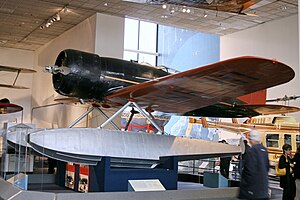Lockheed Model 8 Sirius
| Model 8 Sirius | |
|---|---|
 |
|
| Sirius at National Air and Space Museum | |
| Role | Utility transport |
| Manufacturer | Lockheed Aircraft Limited |
| Designer |
Jack Northrop Gerard Vultee |
| First flight | 1929 |
| Introduction | 1929 |
| Number built | 15 |
The Lockheed Model 8 Sirius was a single-engined, propeller-driven monoplane designed and built by Jack Northrop and Gerard Vultee while they were engineers at Lockheed in 1929, at the request of Charles Lindbergh. Two versions of the same basic design were built for the United States Air Force, one made largely of wood with a fixed landing gear, and one with a metal skin and retractable landing gear, designated Y1C-25 and Y1C-23, respectively. Its basic role was intended to be as a utility transport.
A total of 15 Sirius aircraft were constructed in 1929 and 1930.
The first and best known Sirius was bought by Lindbergh, and in 1931, as NR-211, it was retrofitted to be a float plane. Lindbergh and his wife Anne Morrow Lindbergh flew it to the Far East, where she wrote a book about their experiences there entitled North to the Orient. The aircraft was damaged in Hankou, China, when it accidentally capsized while being lowered off the aircraft carrier HMS Hermes, and had to be sent back to Lockheed to be repaired.
In 1931, György Endresz and Sándor Magyar made a successful US–Hungary transatlantic flight with a Lockheed Sirius 8A aircraft named "Justice for Hungary".
In 1933, the Lindberghs set out again with their Sirius, now upgraded with a more powerful engine, a new directional gyro, and an artificial horizon. This time, their route would take them across the northern Atlantic, with no particular destination, but primarily to scout for potential new airline routes for Pan Am. While at a refueling stop in Angmagssalik, Greenland, the Inuit of the area gave the Sirius a nickname, "Tingmissartoq" or "one who flies like a bird". They continued on their flight and made many stops in Europe, Russia, then south to Africa, back across the southern Atlantic to Brazil and back over the skies of New York City at the end of 1933, after 30,000 miles and 21 countries; droves of people turned out to greet them as they landed.
...
Wikipedia
